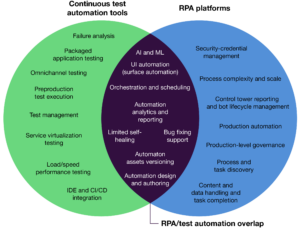RPA And Test Automation Are More Friends Than Foes
COVID-19 taught us an important lesson. As Satya Nadella, CEO of Microsoft, put it at Microsoft Build 2020 to hundreds of developers, “We’ve seen two years’ worth of digital transformation in two months!” Automation supported by intelligent automation platforms — robotic process automation (RPA) plus AI — has already played a role and will continue to do so. In short, if RPA was not on the roadmap before COVID-19, it is now. The focus will be on cost reduction, conducting remote business, and using intelligent automation to improve resiliency, such as by diversifying your supply chain. The surge in automation investment and recessionary pressures may cause risks to skyrocket for businesses:
- RPA bot maintenance, resiliency, and software quality inhibit scale. Keeping bots running in production and providing value is hard and much harder when they malfunction. More incidents will happen, resiliency will struggle, and business will suffer.
- RPA solutions development doesn’t always follow a structured software development lifecycle process. To build a bot, code or scripts have to be written. As bots become more sophisticated, to automate more complex workflows, it will take more design, code, and engineering work.
- RPA solutions don’t really provide all the testing capabilities needed. RPA vendors have recently started building in automated testing capabilities, error handling and reporting, debugging support, or documentation on how to test a bot prior to production. But that is insufficient. As you can see in the figure below, test automation tools come with a wealth of additional testing capabilities.

In our joint report that we recently published, we show how all the competency, technology, and practices developed in the software testing world for the last 30–40 years can and should be leveraged to properly build and test RPA at scale. Test automation technologies have evolved fast in the past years with Agile and DevOps. The strengths that testing brings to the table with its continuous test automation technology are:
- Quality discipline and mindset.
- Simulation and end-to-end testing.
- Nonfunctional test automation.
- Regression functional test automation.
If you want to learn more about how to test your automation, check out our newest report, “RPA And Test Automation Are More Friends Than Foes.” In this report, we discuss in depth how RPA and test automation tools complement each other and what each brings to the table, plus how these two technologies can work together to accelerate innovation and scale automation.
You are also invited to join this complimentary webinar on Tuesday, June 9 at 2pm BST “Avoiding Automation Disaster” to learn what automation options are available to you and how to use them.

